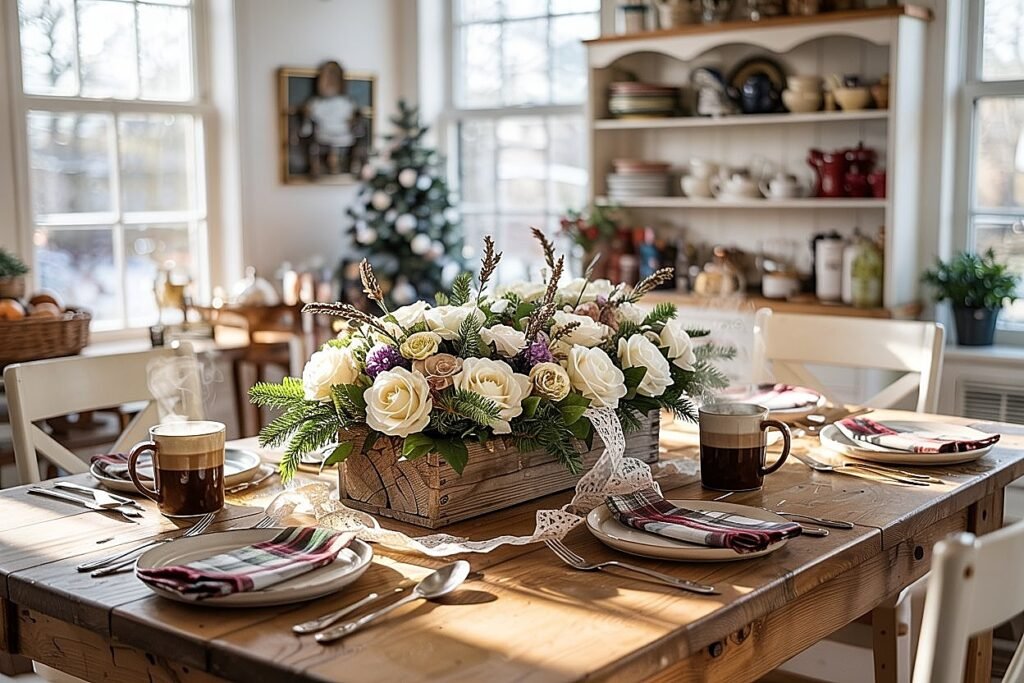
This website contains affiliate links, and some products are gifted by the brand to test. As an Amazon Associate, I earn from qualified purchases. Some of the content on this website was researched and created with the assistance of AI technology.
Key Takeaways
- Small, well-balanced centerpieces outperform oversized arrangements at a crowded brunch table.
- Lavender cools the palette and adds gentle fragrance; roses deliver shape, romance, and color.
- Containers matter: vintage pitchers, rustic crates, and low bowls each change sightlines and mood.
- Layer scent with evergreens, seasonal fruits, and a few pantry spices for a memory-rich table.
- Mix fresh and dried stems for durability; engineer mechanics first so styling feels effortless.
- Color palettes steer the vibe—choose one and echo it in napkins, plates, and ribbon.
- Design for reuse: convert your centerpieces into sideboard vignettes or small take-home posies.
Creating Lavender-Rose Centerpieces for Christmas Brunch sounds fancy, but I build it like a good omelet—few ingredients, precise technique, and a flourish at the end. I chase calm textures, soft fragrance, and shapes that don’t elbow guests or tip wine glasses. The trick is restraint: a handful of stems, one confident container, and negative space that lets everything breathe.
I learned this after designing an overzealous arrangement that blocked Aunt Joan from making eye contact with anyone for an hour. Since then, I keep height low, silhouettes airy, and mechanics invisible. Lavender gives me architecture and perfume; roses add focal points and flesh out the story.
You’ll see plenty of options below—containers, color palettes, evergreens, even fruit and spice pairings. Read with your table in mind: length, lighting, and how your family actually eats. Then build centerpieces that smell like winter and look like a quiet carol.
| 🌿 Centerpiece Style | 🏺 Container Choice | ✨ Accent Materials | 🏡 Placement Options |
|---|---|---|---|
| Lavender-Rose + Evergreen | Weathered wooden trough | Cedar, pinecones, lace ribbon | Main dining table runner display |
| Vintage Pitcher Rose-Lavender | Ceramic / enamel pitchers | Velvet ribbon, trailing ivy | Grouped at center of brunch table |
| Rustic Mason Jar Cluster | Glass mason jars with lace | Twine, dried herbs, tea lights | Individually at each place setting |
| Fruit-Enhanced Lavender-Rose | Galvanized tin buckets | Cranberries, oranges, figs | Accent ends of dining table |
| Candlelit Lavender-Rose | Metal lanterns with inserts | Ivory tapers, fairy lights | Styled down the center table strip |
| Multi-Level Rose-Lavender | Mixed jars, crates, tall vases | Ribbon cascades, dried wheat | Tiered design across the table |
How to Style a Farmhouse Christmas Brunch Table with Lavender-Rose Centerpieces
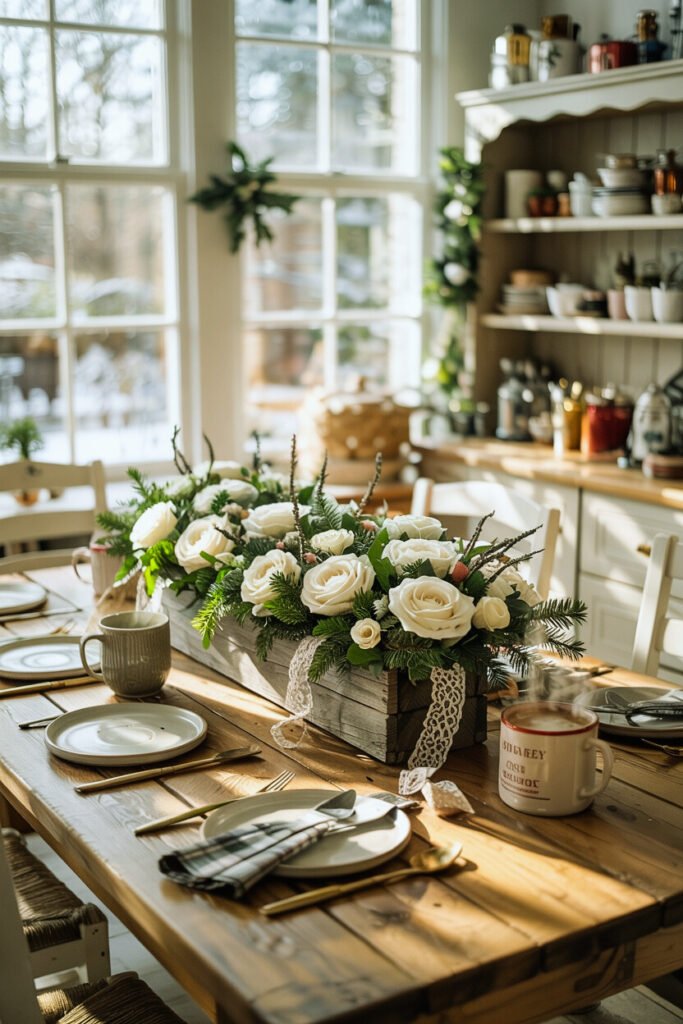
Farmhouse style is all about honest materials and comfort: wood grain, linen napkins, soft candlelight, and flowers that feel gathered, not staged. I keep the layout modular—several small centerpieces instead of one giant showpiece—so platters can weave in and out without a game of centerpiece Jenga.
For proportion, I aim for low and wide. Lavender radiates outward like spokes; roses anchor the look. Everything sits below chin height when guests are seated. Candles? Short tapers or tea lights only—warm glow without heat on petals.
Start with a runner in natural linen or cotton to absorb spills and noise. Place three vessels down the center: left, middle, right. Think in odd numbers for rhythm. Build each arrangement with the same recipe so the table reads cohesive: lavender scaffolding, clustered roses, a touch of evergreen, and one contrasting accent (fruit slice, spice bundle, or ribbon).
Use this quick sizing guide to keep sightlines clean:
| Table Length | Centerpieces | Ideal Diameter | Max Height |
|---|---|---|---|
| 4–5 ft | 2 | 6–7 in | 6 in |
| 6–7 ft | 3 | 7–8 in | 7 in |
| 8–10 ft | 4–5 | 7–9 in | 7 in |
Build each piece in the kitchen, then set them on the table and tweak spacing with plates and platters in place. Mirror the florals in your place cards—one lavender tip and a rose petal glued to a kraft tag. If you want more farmhouse styling ideas beyond the table, I walk through vignettes here: Christmas Sideboard Styling with Lavender and Roses—and if this post helps, share it with a friend who loves holiday brunch. There’s more down the page—color palettes are next and they drive every decision.
What Are the Best Color Palettes for Lavender-Rose Christmas Brunch Centerpieces?
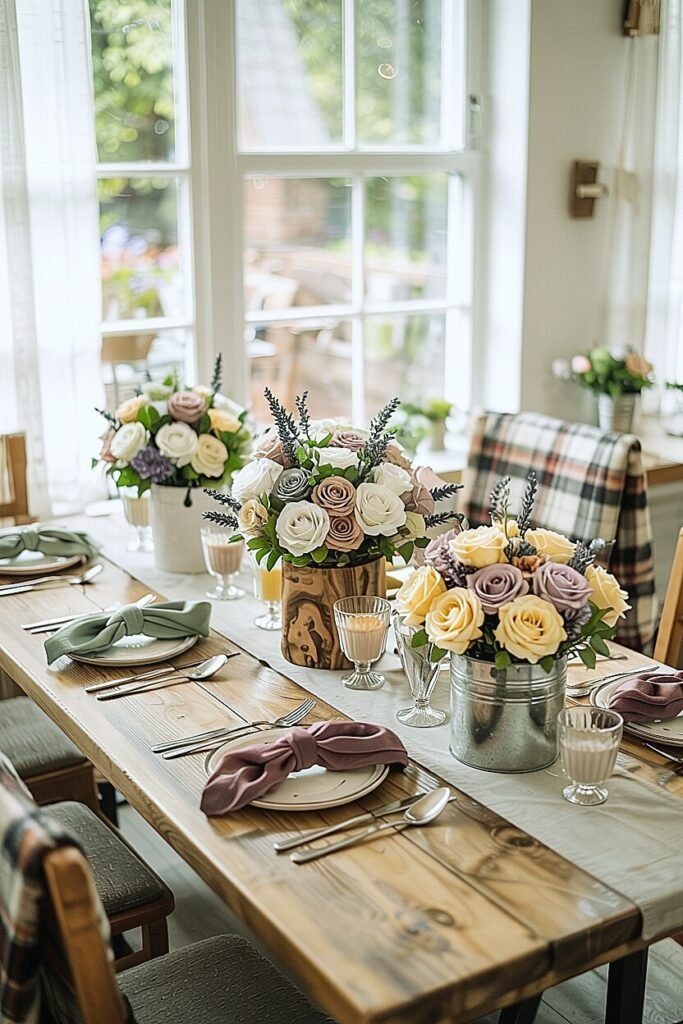
- Blush, lavender, and warm gray. Soft and calm. Use dusty-pink spray roses, English lavender, and a hint of brunia or silver dusty miller. Ground with gray dinnerware or stoneware mugs. This pairing brings winter light indoors without feeling cold. Linen runner in oatmeal pulls the palette together. Add beeswax tapers for warmth and let rose centers provide the only “pop.” Perfect for intimate tables where conversation matters more than spectacle.
- Plum, cranberry, and ivory. Jewel-tone drama for late-morning feasts. Combine deep plum roses, cranberry garden spray, and ivory accent blooms like lisianthus. Lavender cools the richness; add evergreen to bridge tones. Pair with cream ceramic plates and brass flatware. A few frosted cranberries in a shallow dish knit the theme to the plateware. This feels celebratory without shouting.
- Sage, lilac, and soft gold. Low-contrast elegance. Use muted lilac roses, English lavender, eucalyptus, and a whisper of gold ribbon. Sage napkins and pale wood chargers keep it earthy. The soft gold detail should be tiny—think ⅜-inch ribbon tails or small votive cups. The result is ethereal and photogenic, particularly in natural morning light.
- Navy, lavender, and champagne. Elevated farmhouse. A navy runner anchors the table while champagne-toned roses and lavender create a luminous mid-tone. Mix in olive leaves for texture. Clear glass or white ceramic vessels prevent heaviness. Add a slim metallic mesh ribbon for holiday shimmer. This palette flatters white walls and reclaimed wood equally.
- Emerald, mauve, and cream. Botanical and fresh. Choose mauve roses, creamy spray roses, and plenty of cedar or boxwood. Lavender becomes the cool counterpoint. Pair with cream napkins and green glassware. A few pears or green apples on the table echo the emerald notes. It reads winter garden without leaning overly traditional.
- Charcoal, wisteria, and blush. Moody yet gentle. Charcoal plates or slate boards ground wisteria-hued roses and airy lavender. Add blush ribbon to soften edges. The darker base draws candlelight into the flowers. Ideal when your space has black metal accents or darker cabinetry nearby.
- Rust, lavender, and ivory. Warm-cool tension that feels modern farmhouse. Rust velvet ribbon wraps small vessels; ivory roses and lavender keep it bright. Add dried wheat or bunny tail grass to bridge tones. Works beautifully with terra-cotta mugs or burnished copper. Unexpected and memorable.
- Forest green, aubergine, and silver. Deep woodland sophistication. Aubergine roses, lavender, and seeded eucalyptus sit in vintage silver or pewter. Candlelight bounces off metal, highlighting the purple hues. A silver-gray napkin lifts the look from heavy to polished. Best for late-brunch tables that stretch into the afternoon.
- Rose gold, lavender, and snow white. Light, festive, and camera-ready. White roses, lavender, and rose-gold ribbon or votives produce a clean sparkle. Use white stoneware and clear glass for a bright, airy feel. A few star-anise pods as scatter decor nod to spice without clutter.
Color sets mood faster than fragrance hits the air. I start with plates and table textiles, then choose a floral palette that harmonizes instead of competes. Lavender is cool; roses can skew warm or cool—use that lever to control contrast.
Below are nine palettes I’ve road-tested. Each has a distinct vibe and pairs cleanly with farmhouse textures.
Keep it simple: pick one palette, echo it in napkins or ribbon, and let neutrals do the rest. If your room has strong wall color or art, borrow one tone and repeat it once in the flowers for cohesion.
If you’re torn between two palettes, style two small test arrangements. Set them on your table under actual lighting and photograph both with your phone. The better palette announces itself immediately.
If you’re still weighing options, keep reading—your container choice can seal the decision quickly.
How to Use Vintage Pitchers for Lavender-Rose Christmas Centerpieces
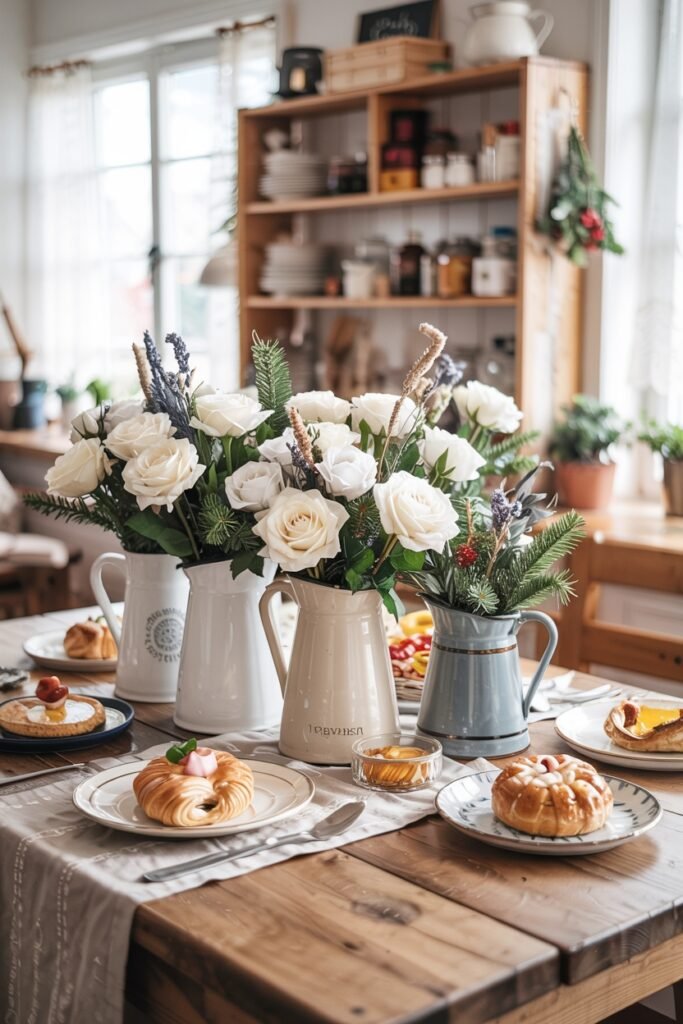
Vintage pitchers are cheat codes. They deliver height, story, and pour-spout charm without much effort. I gravitate toward white ironstone, glazed stoneware, or patterned enamel—each gives a different temperature to lavender’s cool tone.
The key is controlling stem spread so the arrangement doesn’t “mushroom.” Pitchers tempt us to overfill. Fight that instinct and let line do the work.
Build a simple grid with clear floral tape across the mouth (three strips each way). Slip in a nest of chicken wire if you’ve got a wider opening. Start with lavender at a 45-degree angle to establish width, then place your largest roses slightly off-center as focal points.
Use secondary rosebuds at lower heights to create steps. Tuck evergreen and eucalyptus to cover mechanics and add scent. Stop when the silhouette feels like a teardrop with soft shoulders.
Fill ⅔ with water, add a drop of bleach or a penny’s worth of floral preservative, and refresh daily. Rotate pitchers down the table rather than clustering them; the repeating shape creates cohesion. If this sparks ideas, keep reading—the next section explores rustic containers that hit different notes.
What Are the Best Rustic Containers for Lavender-Rose Christmas Brunch Décor?
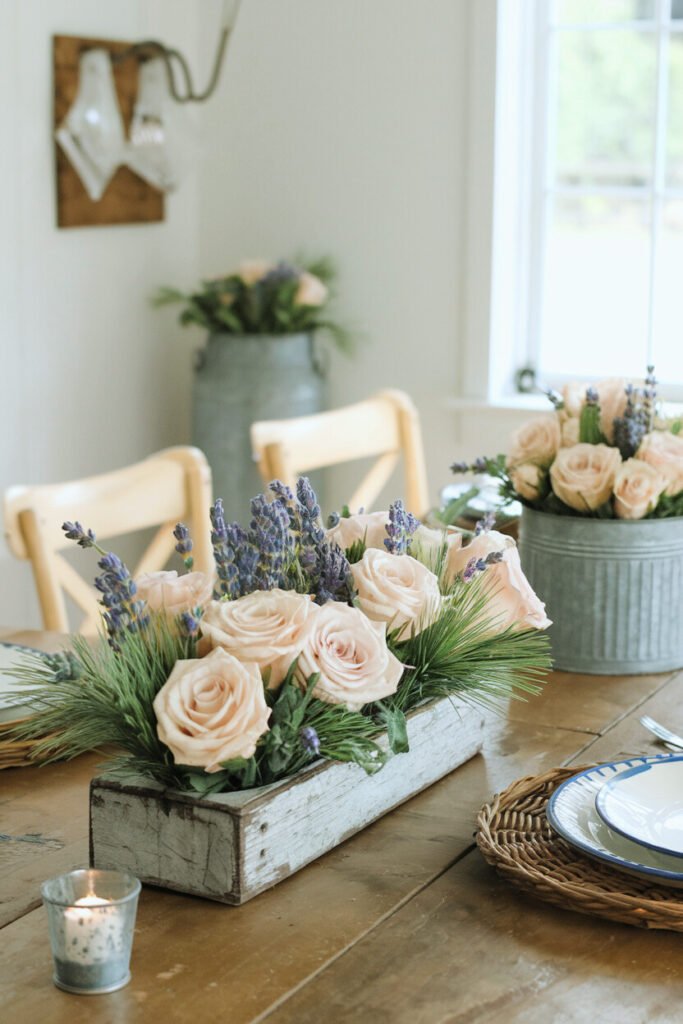
Rustic vessels bring soul to brunch. They also impose boundaries that help your flowers behave. Low bowls keep sightlines wide; crates add friendly height without stiffness.
I pick containers that can moonlight later on the sideboard. Durability first, character a close second.
Before you buy or thrift, check weight and interior waterproofing. Line porous containers with a plastic insert or thin vase. For long tables, alternate low bowls with small jars to create rhythm and easy passing lanes.
Match the container finish to your palette: pale wood for soft schemes, galvanized metal for cooler, wintry looks.
5 Rustic Containers
- Low wooden dough bowl (lined). Perfect for elongated tables. Add a plastic liner, chicken wire, and shallow water. Create a meadow: lavender radiating outward, roses sunk low, cedar bridging gaps. The bowl keeps the silhouette horizontal and inviting. Guests can reach across easily, and cleanup is a breeze—lift the liner, wipe the wood.
- Galvanized caddy with mason jars. Industrial-farmhouse fun. Slip three or four jars into the caddy and treat each as a mini arrangement—lavender, roses, evergreen. The handles make transport painless. Great for buffet-style brunches where pieces might move during service. The metal reflects candlelight subtly.
- Stoneware crocks (small). Weighty and stable, crocks won’t tip when someone nudges the table. Their matte finish flatters mauve and blush roses. Use a tight spiral placement to keep things compact. Crocs read heritage without feeling precious.
- Wicker basket with liner. Soft texture that pairs well with linen runners. Line it, anchor stems in soaked floral foam, and keep height low. Wicker warms cool palettes and feels welcoming. Tuck ribbon tails through the weave for a casual bow.
- Reclaimed wood planter box. Narrow footprint, big payoff. The straight sides corral stems, making it beginner-friendly. Add glass bud vases inside to simplify water changes. Works beautifully down the table center with repeated lavender arcs.
If container talk has you curious about greenery, keep going—we’ll fold evergreens into the mix next.
Ways to Incorporate Evergreens with Lavender-Rose Christmas Brunch Centerpieces
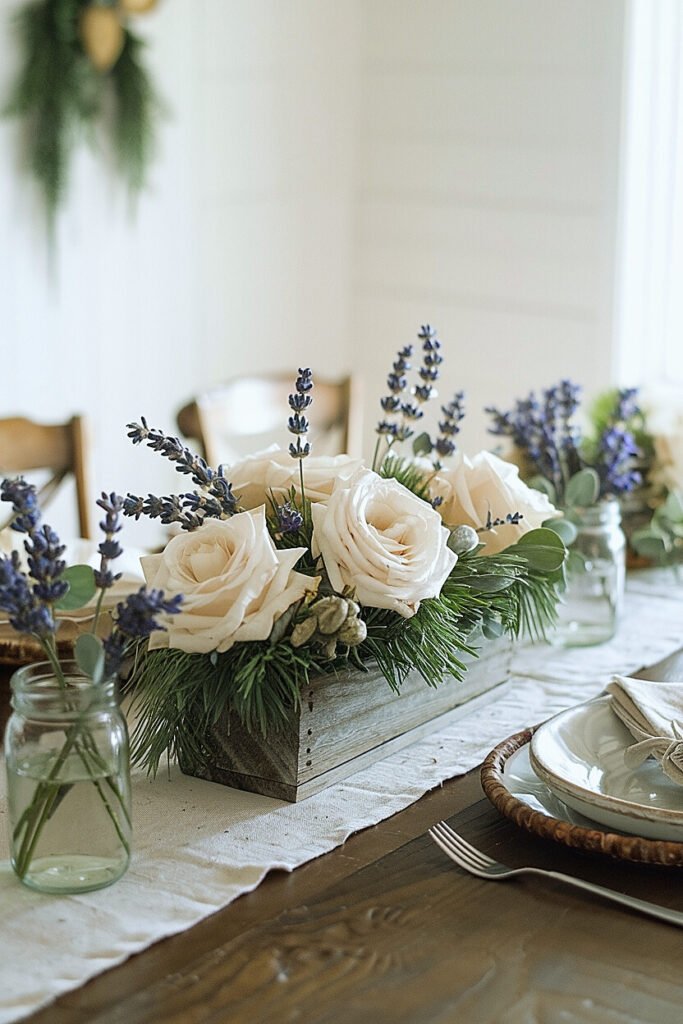
- Cedar collar. Tuck a thin arc of cedar around the container rim before anything else. It hides mechanics and creates a soft, ruffled edge that makes roses feel fuller. Cedar’s warm green flatters mauve and blush palettes and stays pliable indoors.
- Fir spines. Insert short fir tips at 45 degrees to elongate the silhouette. Fir reads “classic holiday” and frames focal roses without stealing light. Trim aggressively—fir bulks fast. Best with jewel-tone palettes.
- Boxwood buttons. Small clusters fill gaps and create tidy geometry. Boxwood lasts forever in water and behaves in tight containers like crocks. Pair with linen runners for quiet luxury.
- Olive or bay branches. Not evergreen in scent, but evergreen in mood. Their silvery leaves bridge lavender’s coolness and warm rose tones. Use sparingly for line and elegance.
- Juniper accents. Blue berries echo lavender; keep it to a few stems to avoid pokes. Juniper adds instant winter character to minimalist arrangements.
- Pine tassels. Short tufts add movement. Snip into tiny fans and place at the lowest level to prevent mess and prickles near hands.
- Eucalyptus halo. Seeded or silver dollar eucalyptus creates a perfumed ring above the rim. It softens the transition between container and bloom, and it dries gracefully for day-two styling.
Evergreens add backbone and winter identity. Lavender can feel summery alone; cedar, fir, and boxwood pull it firmly into December.
I treat evergreens like punctuation—never too many, always intentional.
Prep matters: strip needles below the waterline, and pre-condition stems in a cool bucket for an hour. Mix textures so the arrangement doesn’t read like a hedge. Cedar’s lace, fir’s needles, and eucalyptus discs each do different jobs.
Keep fragrance moderate; the table should smell inviting, not like a candle aisle.
If you want to add edible color and scent, fruit is next—and it’s easier than it looks.
How to Use Seasonal Fruits in Lavender-Rose Christmas Centerpieces
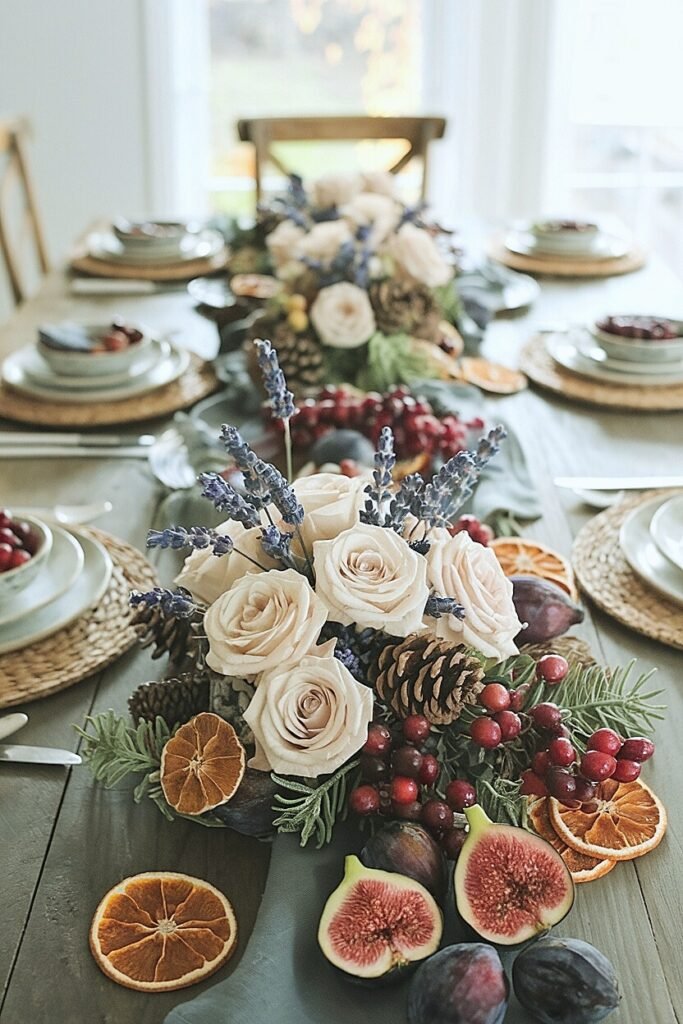
Fruit adds color notes and a lived-in feel. It tells guests, “Relax—this table is for eating.” I lean into citrus and orchard fruit: clementines, pears, pomegranates.
The key is placement. Fruit should nestle, not float. It should read as part of the centerpiece, not a side dish that wandered over.
For large vessels, wire citrus slices (dehydrated) onto wood picks and tuck them near roses. For low bowls, set whole fruit slightly off-center and wedge with foliage so it stays put. Pomegranate halves give burgundy depth; pears echo green palettes.
Keep fruit away from direct candle flame and out of puddled water. Swap fresh fruit after brunch if you’re keeping the arrangement for day two.
Build the florals first, then add fruit where your eye wants color or weight. One piece per arrangement usually suffices. If this opens new directions, keep reading—ribbon details can quietly dial the mood up or down.
What Are the Best Ways to Add Ribbon Details to Lavender-Rose Christmas Centerpieces?
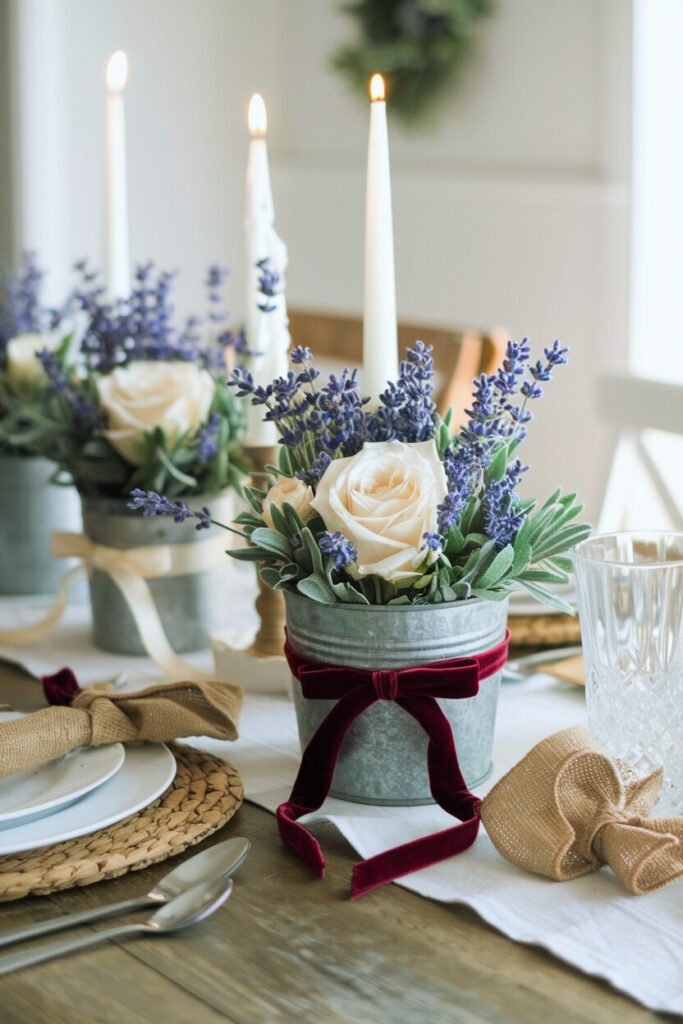
Ribbon brings finish without fuss. I use it to hide mechanics, connect the palette, and add a festive “edge” that flowers can’t provide alone.
Think texture before color. Velvet reads formal; linen whispers farmhouse; metallic mesh adds a glint that catches candlelight.
Treat ribbon like a structural accent, not a bow explosion. Short tails, small loops, and narrow widths keep centerpieces from feeling gift-wrapped. Use it where eyes land: container rim, handle base, or a single loop tucked among roses.
Five ways that work every time.
- Velvet cuff. Wrap a ½-inch strip of velvet around the container’s neck or rim, securing with double-sided tape at the back. It reads polished and hides tape grids or wire edges. Choose a deep tone from your palette (plum, forest) so the flowers stay the star.
- Linen tie-back. Thread a slim linen ribbon through a wicker basket weave or around a crate slat. Tie once, let tails fall. The matte finish complements rustic containers and plays nicely with lavender’s cool tone.
- Metallic mesh loop. One small loop tucked beside a rose adds sparkle without weight. Mesh also lifts candlelight back into the arrangement. Keep it subtle—one loop per piece—so it doesn’t veer into party favor territory.
- Raw-edge silk streamer. A short, frayed streamer introduces movement and softness. Anchor it under an evergreen tuck so only the tail shows. It feels handcrafted and suits farmhouse tables.
- Grosgrain bowlet. A tiny, ribbed bow (two-inch loops) pinned near the container base gives structure and hides mechanics. Grosgrain’s texture keeps the bow from slipping and takes handling well.
If you’re leaning rustic, burlap is up next—and yes, it can look refined.
How to Add Burlap Accents to Lavender-Rose Christmas Centerpieces
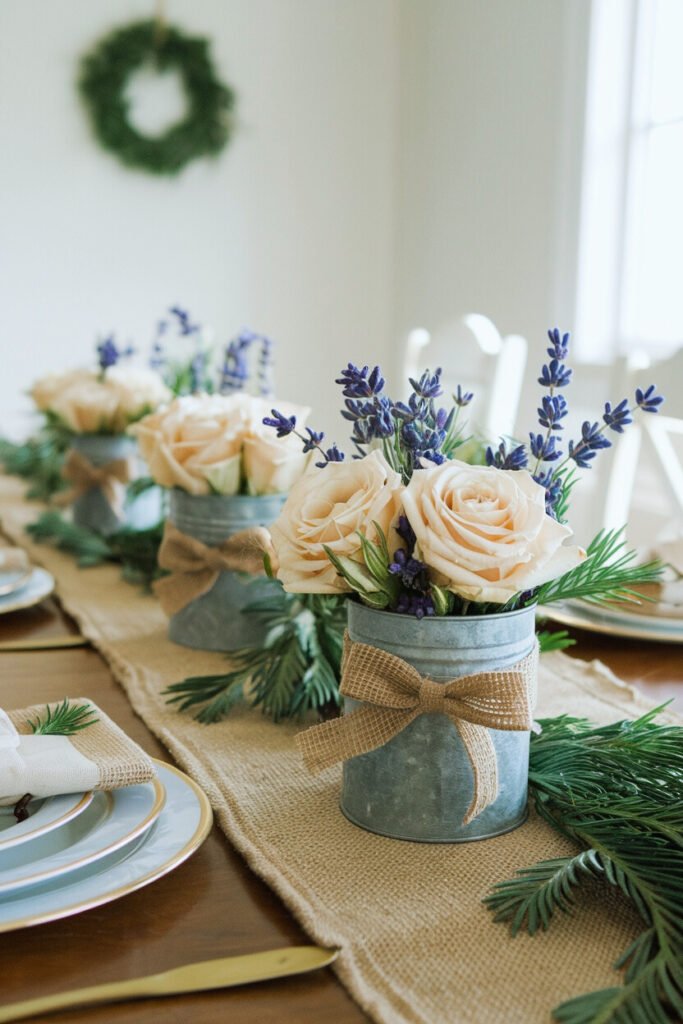
Burlap gets a bad rap for being scratchy and loud. Used sparingly, it’s a warm, honest texture that frames delicate blooms beautifully. I treat it as a base layer, not a star.
Choose finer burlap or “linen burlap” to avoid shedding. Pre-cut clean strips and lightly iron them to remove roll memory.
Wrap a narrow band around the container and secure at the back with hot glue dots or discreet staples. Add a slim linen or velvet ribbon over the burlap to refine the edge. For bowls or planter boxes, lay a burlap runner beneath to visually lift the arrangement from the wood.
If you want a softer effect, back the burlap with cotton muslin—the fibers won’t grab petals.
Keep burlap below the flower line so it never brushes blooms. Use it to connect multiple small arrangements into one visual “run.” If this approach feels promising, keep reading—the spice pantry holds a few surprising tricks.
What Are the Best Seasonal Spices to Add to Lavender-Rose Christmas Brunch Centerpieces?
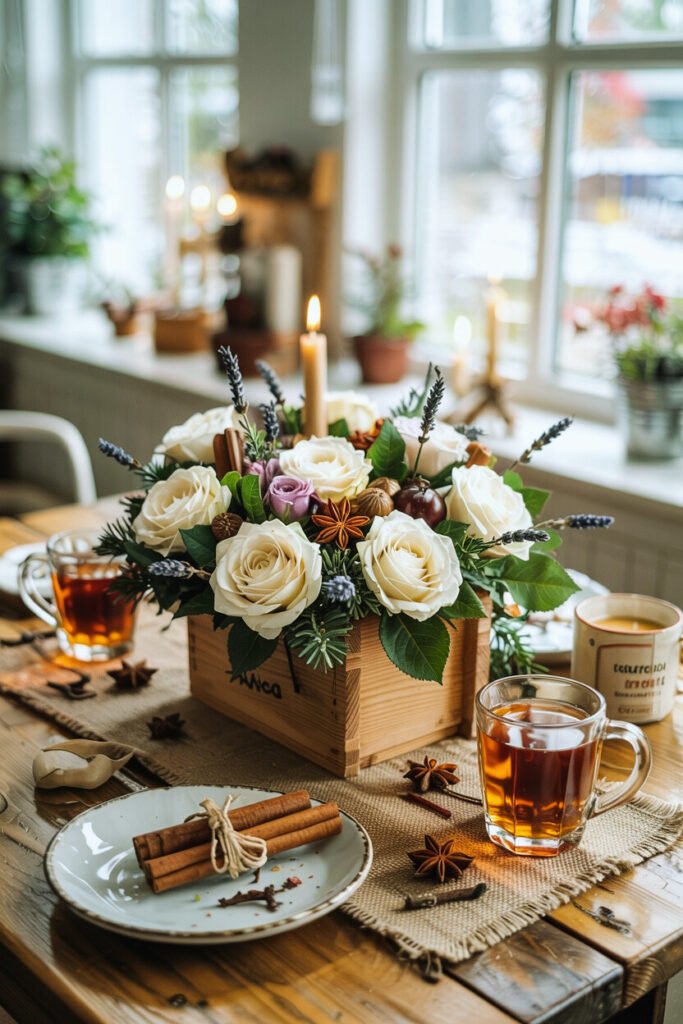
Spice is scent architecture. A few pods or sticks fold warmth into lavender’s cool profile and make the room feel like Christmas without blasting cinnamon at full volume.
I wire spices onto floral picks and tuck them as if they were seed pods—subtle and purposeful.
Keep spices dry and visible; don’t submerge them. One or two per arrangement is enough. Place near roses to create tiny, photogenic moments guests notice when they lean in.
Here are seven favorites.
- Star anise. Those little stars are visual poetry. Wire through a point (gently) and nestle near a rose’s shoulder. They add licorice-spice notes that mingle beautifully with lavender and citrus palettes. Use sparingly; they’re strong.
- Cinnamon sticks. Bundle two short sticks with twine and tuck low in the greenery. They whisper “holiday” without overpowering. Their warm brown also grounds cooler palettes and echoes wooden chargers.
- Whole cloves. Think scatter decor rather than insertion. A small dish of cloves near a centerpiece adds ambient scent. Or stud a citrus slice with a few and pick it into the arrangement for a pomander effect.
- Cardamom pods. Pale green, lightly citrusy, and understated. Thread a few onto thin wire and position by lavender tips. They read as botanical detail more than spice, which keeps the look clean.
- Allspice berries. Peppery, round, and textural. Glue a tiny cluster to a leaf and slide it into a gap for micro-contrast. Great with navy or charcoal palettes.
- Nutmeg (whole). One or two tucked near the base adds sculptural weight and warm aroma. Don’t hide it—let guests spot the “what is that?” moment.
- Vanilla bean. Luxurious and faintly sweet. Tie a short bean to a ribbon loop at the container’s neck. It adds a subtle bakery note without entering dessert territory.
If scent layering intrigues you, keep reading—the final section mixes fresh and dried lavender for form and longevity.
How to Mix Fresh and Dried Lavender in Rose Christmas Centerpieces
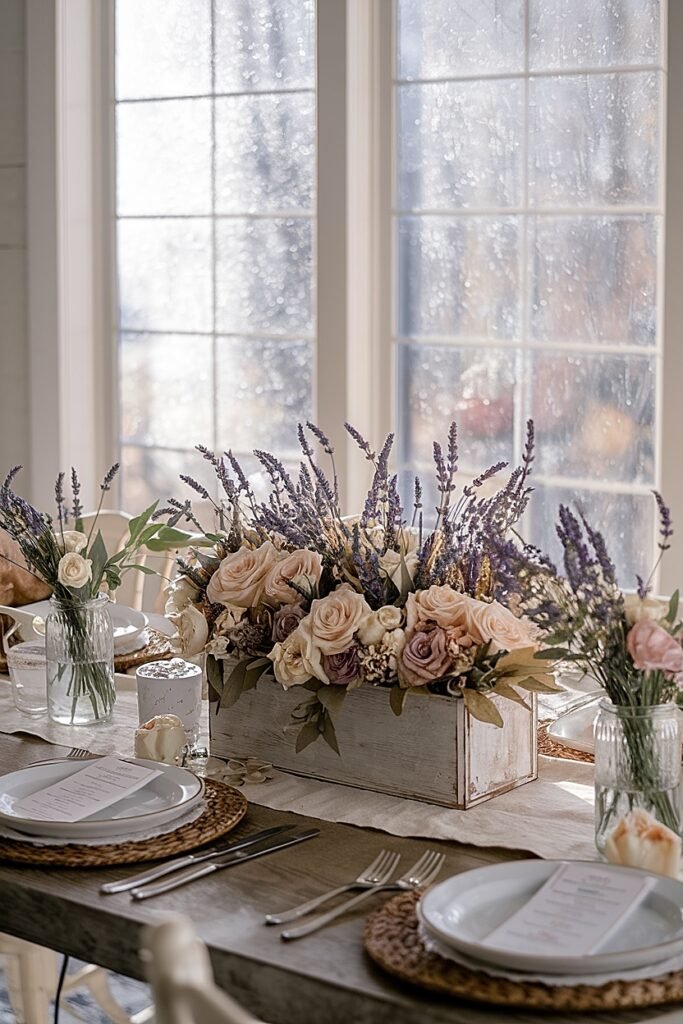
Mixing fresh and dried lavender gives you the best of both: flexible stems for line and sturdy, color-rich spikes that hold shape for days. I use fresh for movement, dried for density.
The ratio that rarely fails is 60% fresh, 40% dried. It looks alive on day one and still photogenic on day three.
Start with dried lavender to sketch the silhouette—gentle fans that set width. Add roses next, then weave fresh lavender through like thread. Fresh stems arc naturally, creating those elegant, airy gestures that make arrangements feel expensive.
Condition fresh stems in cool water for an hour before arranging. Dust dried spikes lightly so they don’t shed on plates. Keep both out of hot candle plumes.
Build the skeleton with dried, paint with roses, and finish with fresh for movement. Refresh water daily and rotate pieces to cooler spots between meals. If this solves shape and longevity, you’ll enjoy the conclusion—quick upkeep notes make tomorrow’s table even better.
Conclusion
Christmas brunch deserves arrangements that smell like a walk after fresh snow and look like they belong on your table, not a stage. Keep the palette intentional, the containers honest, and the mechanics smart. Layer lavender’s cool calm with the warmth of roses, evergreens, fruit, ribbon, burlap, and a hint of spice, then let candlelight do the rest.
Design with reuse in mind—shift pieces to the sideboard after brunch, or break them into small posies for guests to take home. When flowers carry story, scent, and thoughtfulness, the table becomes more than a place to eat; it becomes the quiet center of a very good day.
This website contains affiliate links, and some products are gifted by the brand to test. As an Amazon Associate, I earn from qualified purchases. Some of the content on this website was researched and created with the assistance of AI technology.
